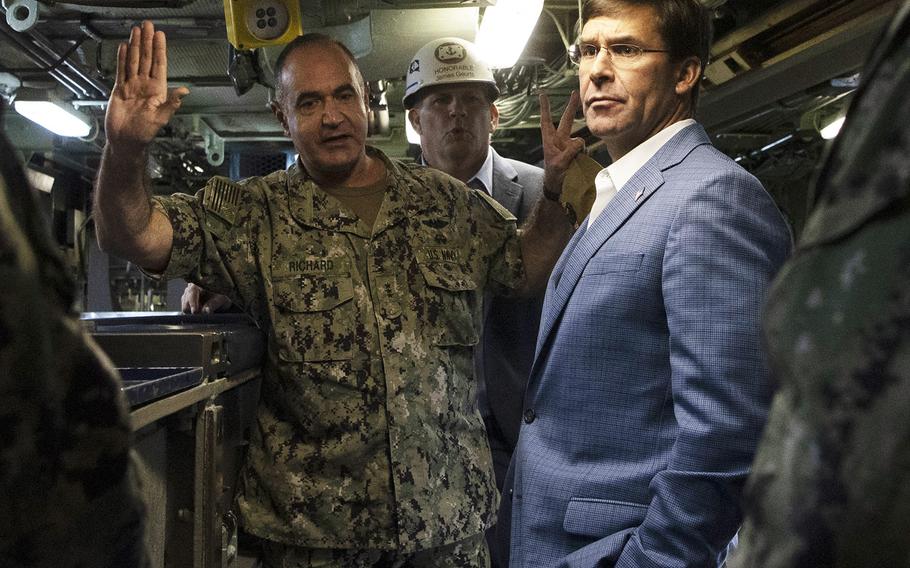
Secretary of Defense Mark Esper visits the USS Boise attack submarine, Norfolk, Va., Sept. 25, 2019. With him is the commander of submarine forces, Vice Adm. Charles Richard. (Lisa Ferdinando/DOD)
WASHINGTON – The Navy’s top submariner will take over command of the U.S. military’s nuclear enterprise after his unanimous confirmation by the Senate last week to become the Strategic Command leader.
Vice Adm. Charles Richard will be promoted to four-star admiral when he takes the helm of STRATCOM at Offutt Air Force Base in Nebraska following his confirmation Thursday. Richard has most recently been serving as the Navy’s submarine forces commander since August 2018. He has also served in recent years as the deputy commander at STRATCOM, according to his Navy biography.
Richard will replace Air Force Gen. John Hyten, who was confirmed in September to become the vice chairman of the Joint Chiefs of Staff, the No. 2 ranking officer in the U.S. military.
In his new command, Richard will be responsible for the three-legged U.S. nuclear enterprise, which can deliver nuclear arms from land- and sea-based missiles and by using aircraft. Richard, like his recent predecessors, listed upgrading the nuclear triad among the top priorities within STRATCOM, when he testified Oct. 24 before the Senate Armed Services Committee. The nuclear enterprise, he testified, must be modernized as soon as possible to ensure the United States can maintain a legitimate nuclear deterrent against adversarial nations such as China and Russia.
"We have delayed and life-extended the triad systems to the maximum extent possible," Richard said. "What I mean by that is we are bumping into physics and engineering limits."
Richard adopted the same opinion as several past STRATCOM bosses on the potential for the United States to use nuclear weapons first in a time of conflict. The admiral said America should retain the right to use such power first, telling the Senate committee that adopting a so-called no-first-use policy could leave allied nations questioning whether they might need their own nuclear deterrent.
"I think adoption of a no-first-use policy would have a significant negative effect on our commitments to our allies," Richard said.
No-first-use policies have been championed by several lawmakers in Congress including Rep. Adam Smith, D-Calif., the chairman of the House Armed Services Committee, and Sen. Elizabeth Warren, D-Mass., a member of the Senate Armed Services Committee and a front-runner among Democrats seeking the presidential nomination in 2020.
Richard is a 1982 graduate of the University of Alabama who has served the vast majority of his career in the submariner community but has also completed assignments at the Pentagon and within STRATCOM, according to the Navy.
He has commanded submarines including the USS Parche and the since-deactivated Submarine NR-1, a one-of-its-kind nuclear-powered, deep-submergence vessel used in a variety of missions including ocean research and installing underwater equipment. His other submarine assignments include service aboard the USS Portsmouth, the USS Asheville and the USS Scranton, according to the Navy.
Richard has also commanded Submarine Squadron 17 in Bangor, Wash., Submarine Group 10 at Naval Submarine Base Kings Bay in Georgia and directed the Undersea Warfare Program at the Pentagon.
With Russia and China modernizing their military equipment, including their own nuclear forces, as they attempt to gain influence across the globe, Richard said the United States must invest in its nuclear enterprise to retain its power and military superiority.
"With the return to great-power competition ... we must never lose sight of the fundamental nature and importance of our nation's strategic forces,” Richard told the Senate committee last month. “A powerful, ready triad remains the most effective way to deter adversaries from conducting attacks against the U.S. and our allies."
dickstein.corey@stripes.com Twitter: @CDicksteinDC